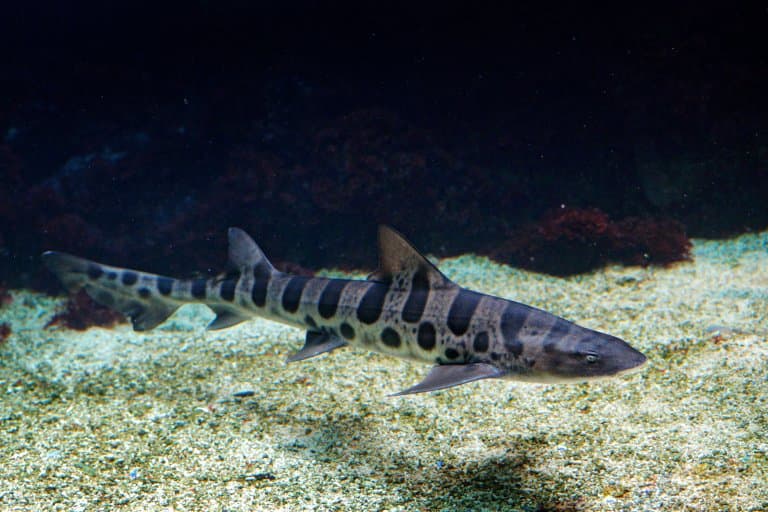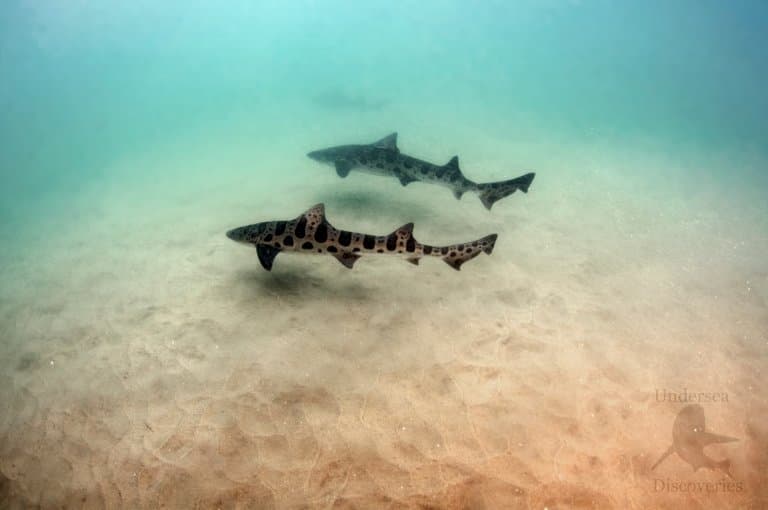Leopard Shark Profile
Predators named after other predators are always fun candidates for the most ominously titled. Wolf spiders, tiger snakes, and tarantula hawk wasps, to name a few.
Leopard sharks not only fit these criteria, but have a scientific name that sounds like a house in Dune, which naturally makes them even cooler.
The leopard shark is a species of houndshark, which are a family of groundsharks. They are easy to identify, due to their large black spots on their back from which they get their name.

Leopard Shark Facts Overview
| Habitat: | Temperate and subtropical waters, shallows, flats and reefs |
| Location: | Northeastern Pacific Ocean |
| Lifespan: | Around 30 years |
| Size: | Up to 1.8 meters (5.9ft) long |
| Weight: | Heaviest-known was 18.4 kg (41 lb) |
| Colour: | Grey-brown with dark spots |
| Diet: | Small animals: shellfish, crabs, shrimp, fish, cephalopods |
| Predators: | Larger sharks, humans |
| Top Speed: | Unknown |
| No. of Species: | 1 |
| Conservation Status: | Least Concern (IUCN) |
Leopard sharks are medium-sized mesopredators of the shallow waters of the North Atlantic coasts. They are social, often form large schools and are a common sight in bays and estuaries, in water less than 4m deep.
They’re specialised estuarine hunters with an adaptable hunting style, and a set of traits that makes them well-suited to patrolling murky waters.
Their diet consists mainly of clams, spoon worms, shrimp, crabs and bony fish.
Their generalist feeding style has kept them thriving where others can’t, and they’re currently listed as of least concern, but this status is in need of an update, and there are worries that the slow reproduction and increasing intensity of commercial fishing poses a threat to the species.
Still, with just a little protection, this species should continue to do well.
Interesting Leopard Shark Facts
1. They are named after the black spots on their back
Leopard sharks are easily identifiable, with a slender body and black saddle-like markings and large black spots on their back and sides, which is what inspired their ‘leopard’ name.
They are a gray, brown (sometimes ‘silver-bronze’ in colour) and measure between 1.2 – 1.5m (3.9 – 4.9 ft) in length with a short, rounded snout.

2. Leopard sharks are adapted for a specific niche
Like all shark species, leopard sharks are highly adapted for their particular niches and as a result, they do what they do very well.
Leopard sharks occupy the brackish waters of estruses and their muddy or sandy flats. They like the shallows, sometimes occupying kelp forests, and in response to the often low-oxygen environments found in these habitats, they’ve evolved to have a higher concentration of red blood cells than other sharks.
The murky water has also led to a reduction in their colour vision, and their eyes have fewer cone cells as a result.
Their keen electroreception allows them to find food beneath the sand and this is pulled into the mouth by a rapid, muscular suction. 1
3. They have teeth on their skin
Like most sharks and rays, their skin is covered in tiny, pointed scales that are called dermal denticles – which literally means ‘skin teeth’.
These overlapping teeth result in a rough texture to touch, and help reduce drag for sharks as they swim, making them fast and stealth like when hunting.
This rough skin also makes it hard for barnacles from being able to settle on their bodies.
4. They’re specialist estuarine predators
This feeding style lends itself to the murky waters of the estuaries leopard sharks inhabit. Two of their most common food sources are clam siphons and Inn-Keeper Worms, and the shark uses adaptable hunting behaviour to pick between them.
Inn-keeper worms are sucked out of their burrows by the mouth of the shark, and clams have their extendible siphons nipped off by the sharp teeth of the shark.
When feasting on schooling anchovies, they use the basking shark technique, swimming in circles with their mouths open. Confused anchovies that stray into the jaws get rapidly snapped up.
This adaptability allows the shark huge success in an otherwise challenging environment. 2
5. Leopard sharks are remarkably social
Not only do these sharks like to hang out in groups, but they’re also very tolerant of other species joining the clan.
Large schools are commonly found, forming cliques based on age and sex, and these include not just leopard sharks but also dogfish, shovelnose guitarfish and smoothhounds of a similar size.
These schools appear to be nomadic, and social hierarchy is observed, and maintained by fin biting. During mating season, female leopard sharks aggregate in the warm shallows in large groups. 3
6. They’re shy
Leopard sharks are not a danger to people at all. Not only are they too small to consider humans as food, but they’re also elusive and shy animals, that flee quickly.
They’re not aggressive, either, and are more than happy to stay away from humans. Sadly, the feeling isn’t mutual. 4
7. They grow slowly
Female leopard sharks give birth to live young, who gestate with the help of a yolk sac inside the mother. She’ll produce any number from 1 to around 40 young in a litter, and the pups will grow at a relatively normal rate for the first few years and then slow down significantly.
By this time, a leopard shark may grow only 4cm in 12 years, and they will take a long time to reach sexual maturity.

8. This could threaten the species
“Depletion” is the word commonly used to refer to the devastation of marine life. It’s a consumerist term, referring to the species (the “stock”) as a resource, and it sums up the total disregard for the animal itself, and highlights the motivation for keeping it alive in the first place.
Conservation research borrows terms like this for convenience, and since there’s no spokesperson for fish, we’ll likely continue to address ocean protection in terms of the highest priority to humanity: the potential damage to the global economy.
On the plus side, the economy is a big motivator and has a lot of people paying attention, so when the IUCN suggests that the slow growth of these sharks puts them at risk of depletion, perhaps there’s more chance that something will be done about it.
This shark is very popular in the aquarium trade for being easy to work with, attractive, and small enough to transport and look after cheaply.
This makes it a target for commercial fishing, and pups are regularly taken for this pursuit. But commercial fisheries also bring up a significant amount of sharks as a food source and as bycatch from trawling, and as this industry intensifies, there is significant potential to rapidly reduce the species. 5
9. Their protection is relatively straightforward
As of 2015 the species was assessed as of Least Concern by the IUCN, but local ‘depletion’ is already occurring in many areas. Imposing size limits in California, where most line fishing of leopard sharks occurs seems to have helped curb their reduction, though their population trends remain unknown.
A major opportunity to protect this species and others like it is to restore tidal mudflats, an ecosystem commonly associated with wasted space. The gestation and mating of this shark rely heavily on these ecosystems, so their protection would go a long way to preventing their decline.
Leopard Shark Fact-File Summary
Scientific Classification
| Kingdom: | Animalia |
| Phylum: | Chordata |
| Class: | Chondrichthyes |
| Order: | Carcharhiniformes |
| Family: | Triakidae |
| Genus: | Triakis |
| Species: | Triakis Semifasciata |
Fact Sources & References
- “Leopard Shark”, San Diego Wildlife Alliance.
- “Leopard Shark”, Elasmo Research.
- “Leopard Shark (Triakis semifasciata) and Spotted Gully Shark (T. megalopterus) Fact Sheet: Behavior & Ecology”, San Diego Wildlife Alliance Library.
- “The Elusive Leopard Shark”, CIMI.
- “Leopard Shark”, IUCN Red List.
